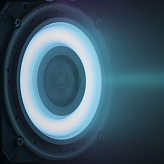Understanding plasma thrusters instabilities


Xenon plasma, gas mixture consisting of electrons, ions and atoms, is of real interest for space propulsion. By ejecting gas at a speed ten times higher than a conventional chemical thruster, plasma thrusters require ten times less fuel. Nevertheless, although plasma thrusters are already operational on several satellites, much remains to be understood about their fundamental behaviour in order to design new generations of more efficient thrusters.
In particular, understanding the transport of electrons in magnetized low-temperature plasmas remains a major challenge for the development of electric thrusters. By focusing on "Hall-effect" thrusters, researchers at the Plasma Physics Laboratory (LPP*) have simulated high frequency instabilities in these plasmas and have shown that they generate an electron-ion friction force which could be predicted theoretically. These results made the cover of the journal Physics of plasmas in June 2020.
This work is conducted thanks to the ANR POSEIDON industrial chair co-funded by the French National Research Agency (ANR) and Safran Aircraft Engines. It is part of Thomas Charoy's PhD work, supervised by Anne Bourdon and Pascal Chabert at the Institut Polytechnique de Paris Doctoral School, and uses an extension of the theoretical model initially developed as part of Trevor Lafleur's CNES post-doctorate at the LPP.
> For more information: LPP website.
> Learn more: First successful launch for iodine-propelled spacecraft
* LPP, a Joint Research Unit CNRS - École polytechnique - Sorbonne Université – Université Paris-Saclay - Paris Observatory
 Support l'X
Support l'X